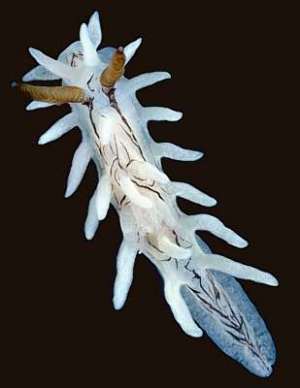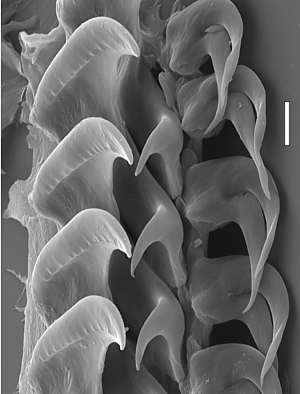

Okenia vena
Rudman, 2004
Order: NUDIBRANCHIA
Suborder: DORIDINA
Superfamily: ANADORIDOIDEA
Family: Goniodorididae
DISTRIBUTION
Known only from northern New South Wales, eastern Australia.
PHOTO
Upper Right: Pig Is, Coffs Harbour, New South Wales, Australia, December 1990, 9 mm long, AM C164620. Photo: Bill Rudman. Lower Right: Section of right side of radular ribbon. Note large pointed secondary spine on the outer corner of the inner teeth and large bicuspid outer teeth. Pig Is., Coffs Harbour, New South Wales, Australia, 8 December 1990, AM C164606. Scale bar = 10 µm. Photo: A.C. Miller.
The body is elongate, with a distinct mantle edge bearing 7- 8 cerata-like papillae on each side, all of similar length, approximately the width of the mantle. There is a single mediodorsal papilla about midway between the head and the gills, and a group of 3 or 4 papillae arranged in a transverse line just in front of the gills. There is also a single papilla in the mid-line, just behind the gills, but sometimes there can be a pair. There are up to 7 gills arranged in an arch around the anal papilla in the postero-dorsal midline. The head has a pair of broad, flattened oral tentacles. This species grows to at least 10mm long alive. The whole of the body is a translucent white, with an irregular pattern of dark brown lines arranged in a longitudinal and diagonal network on the dorsum and the sides of the body. In some specimens there can be some brown 'smudging' on the papillae, and in others, the translucent white gills can have the inner edge of the rachis lined with brown. The rhinophores are orange-brown
The radula is fairly typical of the Goniodorididae The innermost tooth has a broad base and a long elongate pointed cusp and has only faint indications of denticulation. There is a large pointed spine on the dorso-lateral corner of the base of the tooth. The much smaller outer teeth have two very large, slightly recurved, pointed cusps
This species has a very distinctive colour pattern. It has been found with Okenia purpurata, which is similar in external shape, on the same bryozoan colony, but the colour pattern of the two species is quite different with Okenia purpurata having a purple body and white papillae. Okenia purpureolineata Gosliner, 2004 has similarities in shape and colour, but in that species the network of lines on the dorsum are purple, the background colour and the papillae are purplish, there is a different arrangement of dorsal papillae, and the shape of the radular teeth are quite different, with prominent denticles on the innermost teeth and no distinct cusps on the outer teeth. It is found on the ctenostome bryozoan Amathia tortuosa Tenison Woods, 1880.
-
Rudman, W.B. (2004) Further species of the opisthobranch genus Okenia (Nudibranchia: Goniodorididae) from the Indo-West Pacific. Zootaxa, 695: 1-70.
Rudman, W.B., 2004 (December 21) Okenia vena Rudman, 2004. [In] Sea Slug Forum. Australian Museum, Sydney. Available from http://www.seaslugforum.net/factsheet/okenvena
Related messages
-
Okenia purpurata & Okenia vena together
From: Leanne & David Atkinson, January 25, 2007 -
Okenia vena mating
From: Leanne & David Atkinson, January 17, 2007 -
Okenia vena from Port Stephens, NSW
From: L. & D. Atkinson, February 22, 2006
